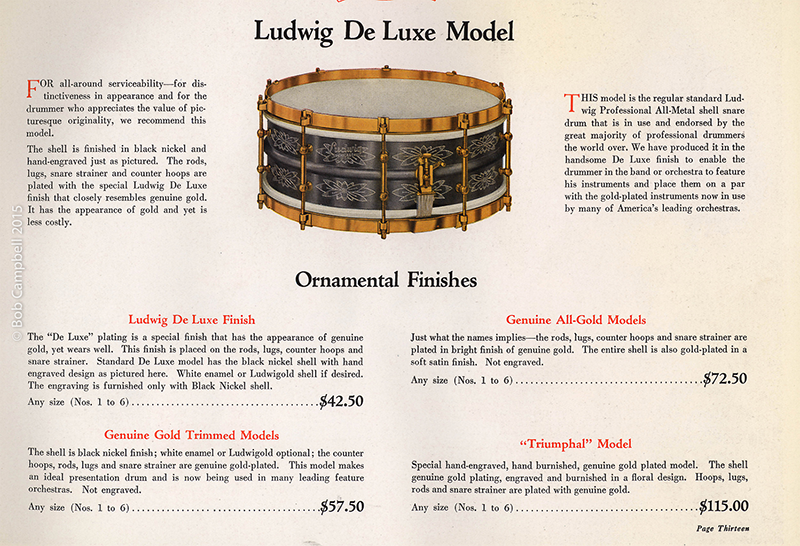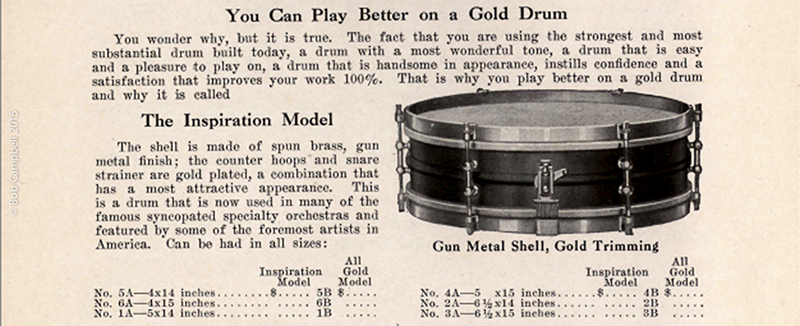In June of 2013, I had the great pleasure of visiting Bun E. Carlos’ “drum barn” to pick up a 1920’s Ludwig Wild Rose Triumphal (see NSMD Featured Articles, January, 2014). Bun E. was very kind to give me a tour of his amazing drum collection. I took quite a few pictures with my trusty Nikon D800 expecting that I would never see a collection like this ever again. Recently, I started looking through these pics, zooming in on the details that a wonderful DSLR allows. No, this is not an advertisement for Nikon! My eyes kept returning to the far left corner where many exquisite and rare 1920s-1930s Ludwig & Ludwig drums were placed. Third from the left, next to a Ludwigold and Stipelgold, there appeared to be a 10-lug, non-engraved Black Beauty, circa 1920s (p-338 strainer), with gold-plated hardware. Actually, there was some engraving but only the “Ludwig – Chicago - USA” logo. No scroll – no florettes. While the drum showed some wear-and-tear for its ~90 year lifespan, I was pretty sure there were very few of these around in any condition. Eventually, the allure became too much and I emailed Bun E about selling me the drum. To make a long story short, the drum made its pilgrimage from Rockford, IL to Carmel, IN about a month later. At the time, I did not know very much about these drums, but my curiosity made me dive deeper.
The first example of a non-engraved Black Beauty that I encountered was in Mike Curotto’s 2006 book, “The Curotto Collection.” On page 98-99 to be exact, there was a picture of a 1924-25, 5X14”, 8-lug, Ludwig & Ludwig Gold Inspiration model. With the exception of the number of lugs (8 vs. 10), it was almost identical to the drum I got from Bun E. - almost. Being a true drum nerd, I looked more closely at the engraved logo. On Mike’s 1924-25 Inspiration model, “Ludwig” was scripted with “CHICAGO” in block letters below. On my Inspiration 10-lugger, “Ludwig” was scripted but underneath was “CHICAGO” and “USA”. Over the letter “i” in “Ludwig” of Mike’s drum was a squiggly line while mine had a rounded dot. Clearly, these were different engravers at work and/or drums from a slightly different time period. For the totally anal-retentive, the logo on the 1924-25 Inspiration was just to the left of the strainer, while mine was one panel removed to the left. I contacted John Aldridge, resident master engraver and vintage drum expert. He said this was likely from around 1926-27 “because the Professional strainer came out in late 1927.”
Looking through my 1927 Ludwig catalog (page 13), I noticed that the Ludwig logo engraving on the 10-lug De Luxe model was virtually identical to mine. Like the 1927 Ludwig De Luxe, my drum had a center-beaded, two-piece soldered shell, 10-lugs, a p-338 strainer, and bearing edge bent back to the shell forming a triangular air chamber (one of the aspects of these drums that I believe makes them sound so unique). As mentioned earlier, my drum had gold-plated hardware; though scratched and worn it had the survived the test of time. I looked closer at the catalog page and saw various “Ornamental Finishes” listed below the pic. The “Genuine Gold Trimmed Models” read, “The shell is black nickel finish; white enamel or Ludwigold optional; the counter hoops, rods, lugs and snare strainer are genuine gold-plated. This model makes an ideal presentation drum and is now being used in many leading feature orchestras. Not engraved. Any size (Nos. 1 to 6)…$57.50.” Correcting for inflation, this would be about $800 in today’s dollars - pretty reasonable in my humble opinion given the quality of craftsmanship. I assumed “not engraved” meant no floral pattern on the shell and excluded the logo. To be sure, I checked in with John Aldridge again, explaining my observations from the 1927 catalog. John said, “Hey Bob, my vote is for the gold trimmed moniker as opposed to the Inspiration. The reason is supported by your own observation. The style and content of your logo is consistent with this found on 10-lug flower engraved models from 1927. That makes it a more accurate choice to use the 1927 catalog name and also allows you to point out how Ludwig would rename an older model when a design element changed (8 to 10 lugs). The locations of the script engraved logo are standard: left of strainer for eight lug models, one panel left of strainer for ten lug models. There are a few with misplaced logos, but the standard placement is by far the most common.”
So while I nailed down the drum’s identity, I was at a loss to find any of the previous owners prior to Bun E. I keep wondering who was the drummer who bought and played this drum almost 90 years ago. I wish I knew… In a previous catalog, Ludwig stated, “You can play better on a gold drum. You wonder why, but it is true.” Well, I’m not so sure but I am to find out!
All said and done, this is a pretty rare drum. I feel privileged to be its custodian for the next generation. Now it’s time to send it off for a bit of gentle cleaning and preservation (by Mike Curotto, one of the few people I’d trust with such a delicate task). Hopefully, I’ll remember to send some before-and-after pics! Mike does amazing work. Best wishes and keep hunting for those musical treasures.
Many thanks to Bun E Carlos, John Aldridge and Mike Curotto for their help with this article; they are a wealth of knowledge and inspiration (no pun intended!).









